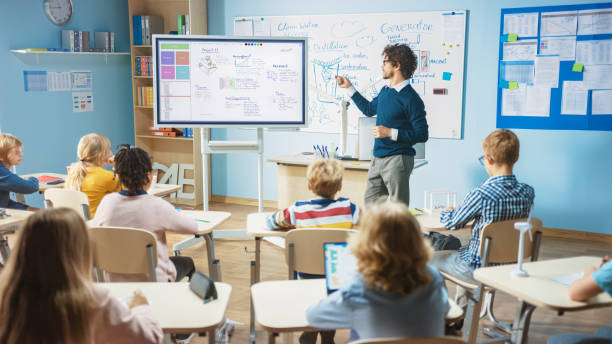Top Primary Science Tuition Singapore to Help Your Child Excel
Top Primary Science Tuition Singapore to Help Your Child Excel
Blog Article
Exploring the Various Mentor Strategies in Primary Scientific Research Education Today
Inquiry-based discovering, hands-on experiments, and the combination of modern technology are redefining just how teachers engage young minds. Additionally, collaborative approaches and separated instruction are being utilized to provide to the diverse demands of students, improving both engagement and understanding.
Inquiry-Based Discovering
Inquiry-Based Learning (IBL) is a pedagogical strategy that encourages trainees to explore clinical concepts with questioning, investigation, and hands-on testing. This approach emphasizes the function of students as active participants in their learning, advertising critical thinking and analytical abilities. By engaging with real-world inquiries, pupils come to be motivated and curious, which boosts their understanding of scientific concepts.
In IBL, educators serve as facilitators, guiding students as they navigate their inquiries instead than providing details straight. This student-centered approach permits differentiation, fitting various learning rates and designs. Trainees create abilities in creating theories, designing experiments, and examining data, which are essential for scientific literacy.
In addition, IBL fosters partnership among trainees, motivating them to share ideas and findings. This cumulative questions promotes social skills and a feeling of community within the classroom. Additionally, the process of inquiry encourages resilience, as pupils learn to embrace failure as a stepping rock toward understanding.
Hands-On Experiments
Hands-on experiments are a crucial part of effective science education, matching the principles of inquiry-based discovering. These experiments enable students to involve straight with scientific principles, cultivating a much deeper understanding through experiential understanding. By manipulating products and observing end results, young learners can understand abstract theories in tangible methods.
Such activities promote important thinking and analytical abilities, as pupils assume end results, conduct experiments, and evaluate outcomes. This process motivates them to ask inquiries, fine-tune their understanding, and establish a scientific attitude. Additionally, hands-on experiments can be tailored to varied discovering styles, ensuring that all pupils have the opportunity to engage meaningfully with the material.
In addition, hands-on experiments commonly encourage cooperation among peers, promoting teamwork and communication skills. Working in teams makes it possible for trainees to share concepts, talk about searchings for, and find out from one an additional, which enhances their overall educational experience.
Integrating hands-on experiments into the primary scientific research curriculum not only enhances the discovering atmosphere yet also grows a lifelong rate of interest in science. By actively joining their education, students are most likely to develop an enthusiasm for clinical query that extends past the classroom.

Modern Technology Integration
Integrating technology into main scientific research education and learning has actually come to be progressively vital in fostering student engagement and enhancing learning results. Using digital devices, such as interactive simulations, digital labs, and academic software program, provides pupils with chances to discover clinical principles in innovative ways. These sources facilitate a much deeper understanding of intricate topics by allowing students to envision and control variables that would be impractical in a conventional classroom setup.
Moreover, technology combination motivates personalized a fantastic read discovering experiences. Trainees can progress at their very own rate, reviewing challenging concepts with multimedia resources, which cater to various learning styles. This flexibility not just supports private development yet also cultivates a feeling of autonomy in students.
Additionally, modern technology works as a bridge to real-world science, linking trainees with present study and professional payments. Accessibility to clinical journals and online click here to read data sources broadens students' perspectives on scientific query and cultivates vital assuming abilities.
Collaborative Discovering
Joint understanding plays a crucial role in main science education by cultivating synergy and communication abilities among trainees. This approach encourages learners to interact, share understanding, and involve in problem-solving, which enhances their understanding of clinical concepts. By getting involved in group activities, students learn to express their ideas, listen to diverse point of views, and bargain options, all of which are necessary abilities in both scholastic and real-world contexts.

Research suggests that collaborative understanding can result in enhanced inspiration and interaction in science subjects, as trainees locate pleasure in shared experiences (primary science tuition Singapore). Furthermore, this strategy prepares students for future collective ventures, equipping them with the abilities required for effective synergy in higher education and learning and expert settings. Inevitably, accepting collaborative discovering in key scientific research education and learning can substantially enhance the understanding experience and advertise a deeper understanding of clinical questions
Distinguished Guideline

Separated instruction can show up in different ways, such as differing the material, processes, or products of discovering. Instructors may make use of tiered tasks that give varying degrees of intricacy, allowing trainees to function at their respective preparedness levels. Furthermore, versatile organizing approaches can promote collaboration amongst trainees with various capacities, promoting peer knowing.
Evaluation plays an essential duty in this strategy, as it informs direction and aids educators comprehend each trainee's unique requirements. Formative assessments, such as observations and tests, can lead educators in changing their approaches to improve discovering outcomes. primary science tuition Singapore. Eventually, by applying distinguished instruction in main science education and learning, teachers can cultivate an extra reliable and equitable discovering environment, encouraging all students to reach their full possibility in comprehending scientific sensations
Conclusion
In summary, the diverse training strategies in primary scientific research education and learning, consisting of inquiry-based understanding, hands-on experiments, technology assimilation, collaborative knowing, and set apart guideline, jointly add to a much more efficient knowing atmosphere. These methods advertise essential reasoning, problem-solving skills, and a deeper understanding of scientific ideas. By applying these approaches, teachers can create helpful and appealing classrooms that address the different demands of students, eventually fostering a lifelong interest in science and boosting scholastic success.
Inquiry-Based Learning (IBL) is an instructional approach that urges trainees to explore clinical ideas via wondering about, investigation, and hands-on trial and error.Joint discovering plays an important function in main scientific research education by fostering synergy and communication abilities amongst students.Research shows that joint understanding can lead to enhanced inspiration and interaction in science subjects, as students discover satisfaction in common experiences.In cultivating a comprehensive understanding atmosphere, differentiated direction arises as a crucial strategy to fit the diverse demands and abilities of students in primary science education. Inevitably, by carrying out distinguished instruction in main science education and learning, teachers can cultivate a more fair and efficient understanding environment, empowering all trainees to reach their complete possibility in understanding clinical sensations.
Report this page